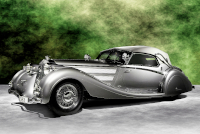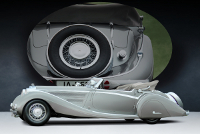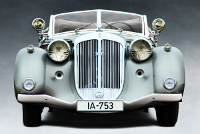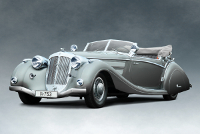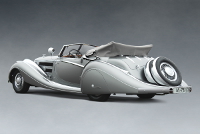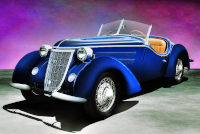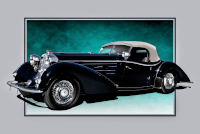Location:
Pebble Beach Concours d'Elegance, 2009
Owner: Anne Brockinton Lee & the late Robert M. Lee | Sparks, Nevada
Prologue:
Back in 2009, when this Horch won best of show at Pebble Beach, I felt privileged to stand among the real photographers and snap a few appropriately positioned telephoto images. But I did not linger, the end of a long day. What I missed, an opportunity to photograph the car with its hood up, I long regretted because Horch automobiles look best when fully closed.
Approaching the end of 2024, I undertook a small effort to properly address Auto Union and Horch. Wandering past Wikipedia, I could only applaud Mr. Ginn for a nicely snapped image of chassis #853558. But then noting that he published the image as property of the public domain, I thought, I could very well use it to create a sparkly version for our Auto Union redress.
Note, I hold copyright over the image depicted here as derivative work, not to stir up any confusion. A day's work to fix the original, draw and paint, so the claim is just. And in the spirit of sharing I don't charge fees, collect data, run adverts, or use 12cylinders for capital gain. The point in this exercise is merely to provide a visual that celebrates a fantastic automobile.
Not to malign my old images; they work well and I still like the patina from that old sensor. In fact, I remember browsing our local Barnes & Noble back at the Inner Harbor in Baltimore one afternoon... I picked up a coffee table book of classic cars, flipped through, and found a two-page spread of this Horch in a rear-quarter perspective identical to image 5 shown here. Whoever prepared the image had cut and fixed the car in a similar manner with a similar grey backdrop, and for a split-second I wondered whether someone had actually used my illustration without telling me. But no, the shadows, chrome, and reflections all remained untouched, the image superimposed without any illustrative work. Still, I thought it was a smidge flattering.
Now here I've gone and toyed with creative commons material, but hopefully for a worthy cause. And at last I'm coming around to the merit of the Horch 853. I did not immediately rah-rah the car, despite how truly bombastic its figure may be. Horch is a marque affected by stigma, not without cause, whose luster has worn off through late 20th century obscurity.
Somewhat strangely, I'd known of this particular car for a very long time, first spotting it in an old classic car book as a child. The lone picture focused on the rear deck and double continental kit, and back then the car was painted black. This same black iteration appeared in Automobile Quarterly in September of 1994, when Herbert W. Boyer owned the car. So seeing #853558 at Pebble Beach closed a cerebral loop I hadn't realized was left open. I never felt any need to learn more about an obscure German luxury auto of no particular performance character. But now having slid back into the territory I'll gladly look at the material afresh. This latest image update represents better intentions for our collective benefit.
- - - - - - - - - -
► Image Source 2-5: Nikon D200 (10.2 MP)
Image Source 1: Mr. Steve Ginn, Petersen Automotive Museum, 2016, used by the author under Creative Commons CC0 as a base for this illustration (21.5 MP).
References:
- Automobile Quarterly, Volume 33, Number 2, September 1994, "Horch, The August Motor Car" by Hans-Otto Neubauer, The Kutztown Publishing Company, Inc., Kutztown, PA, p. 18-19, 21-22, 28-29
- Automobile Quarterly, Volume 4, Number 2, Fall 1965, "Cars Named After August Horch" by Richard von Frankenburg, The Kutztown Publishing Company, Inc., Kutztown, PA, p. 140-142, 145
- UltimateCarPage: A brief summary focused more on Horch than on chassis #853558, but the visuals are nice, by Wouter Melissen, August 17, 2009. I would have been standing next to Wouter just then, though I also remember walking off on my own to photograph the fascia, at a distance, thinking, 'Is this okay? Is everyone just going to stand in the same spot?' But eventually folks moved about. And Wouter's shots are archetypal; they are the images that pop into mind when thinking about the Horch 853.
- Wikipedia: A very brief summary of #853558, one we owe to Mr. Steve Ginn, this citation points back to the public domain image described above.
- ZF: The manufacturer provides a description of its Aphon transmission and how it works.
Though to most it is an obscure marque, Horch was a formidable competitor of Mercedes-Benz in Germany, and the 853 sold well against Mercedes' premier offerings, the 500K and 540K. As a policy, Horch produced more affordable options than Mercedes-Benz, and the car's technical development reflects a rational approach more than cost-no-object prestige.
A strong, somewhat pedestrian (Horch would have said refined) cast iron 8-cylinder motor powers the chassis, providing about 105 brake horsepower to move nearly three tons of automobile. The modified 853A offers more power thanks to an alloy head and cam refinement, but the standard 853 is something of an aristocratic Clydesdale.
Horch 8-cylinder development begins with Paul Daimler, son of Gottlieb, who first lends his talents to a 3,132 cc unit in 1926, the timing of which brings the Horch Model 830 in line with prevailing trends, a step forward for German luxury automobiles. Fritz Fiedler and Hans Schleicher succeed Daimler in 1929; they revise the plan, but in a modular fashion that allows Horch to build 3.0, 4.0, and 4.5-litre motors by varying the bore, with all units based largely on the same components. 1931 also sees development of a 6.0-litre 66-degree V-12, of which only four examples survive. But in keeping with Horch's economic approach to sound luxury, the modular 8-cylinder is more appropriate.
Contrary to its conventional powerplant, the Horch 853 benefits from an advanced chassis design of early independent configuration at all four points. In particular, the rear assembly comes about through a contract with Ferdinand Porsche, who in 1931 receives a patent for his independent torsion bar unit.
While rational luxury may be the ethic that guides Horch development, a few special models receive custom coachwork to explore what is possible at the upper echelons of prestige. This 853, for instance, is intriguing in that it is not one of the Special Roadsters positioned opposite the 540K, but dons perhaps the most extravagant custom coachwork of any Horch. The concept is grand, and yet the design still exhibits characteristic attributes that connect the car to the broader Auto Union range.
Subsequent to an extensive restoration, this Horch won Best of Show at the 2009 Pebble Beach Concours d'Elegance, source of our original photographs, albeit a condensed set. The car is a quintessential Pebble car, an immense confection of chrome and curves. Later, in 2014, chassis #853558 won Best of Show at Amelia Island.
The world knows little of this chassis' origins, the Voll & Ruhrbeck factory having been destroyed during World War II, obliterating all build and delivery records. The car was at one point claimed by the French army, and after the War surfaced in Switzerland. Although the car was close to complete upon arrival in the U.S., RM Restorations used period photographs to fabricate new front and rear bumpers, and a new bonnet. All remaining panels are original. Initial restoration consumed about five years, with half the time dedicated to chrome, upholstery, and woodworking details.
Doctor Boyer of San Francisco owned the Horch at the time, (when #853558 appeared in AQ), before the car passed to Anne Brockinton Lee and the Late Robert M. Lee. The Lee's in-house team completed a second restoration prior to Pebble Beach in 2009, which brings to car to its present state depicted here.
Motor: 4,944 cc Type T850 straight 8-cylinder | 87 mm x 104 mm | 6.1:1 compression
Fritz Fiedler and Hans Schleicher simplified Paul Daimler's 8-cylinder plan. In 1926, Daimler designed a long-stroke DOHC design, shaft-driven, with direct valve actuation and accessories driven not by belts, but by 14 bevel and helical gears. The new motor is much less complex and of a more conventional bore and stroke (87 mm by 104 mm). Direct valve actuation remains along with vertical shaft drive, but uses a SOHC with belt drive for the accessories. Cooling treats each cylinder as a separate unit within the cast-iron block, rather typical of any modern motor, whereas Daimler had paired the cylinders together to create a short block on five main bearings. So the new design is less of a technology for technology's sake approach, and more of a reasonable plan that provides Horch with respectable flexibility for the remainder of the decade.
Valvetrain: SOHC, 2 valves per cylinder
Aspiration: single Solex 35 JFF carburetor
Power: 105 bhp @ 3,200 rpm
Drivetrain: ZF Aphon 4-speed gearbox, rear-wheel drive
Horch models drive the wheels through an Aphon G 30 gearbox developed by ZF in 1929. The model uses spur gears on first and reverse, and helical gears on second, third, and fourth, the primary advantage being quiet operation. ZF state that 'Aphon' means 'without sound' in Greek. (Take the root 'phōnētikos' meaning 'spoken,' as in 'phonetics' or 'telephone,' then add the Greek prefix 'a-' to the word meaning 'not-' and the meaning is 'soundless.') The unit uses a staggered layout with overdrive on all forward gears, providing eight speeds total, a wholly modern concept of luxury that helps sustain higher cruising speeds.
Front Suspension: independent, upper A-arms with lower transverse semi-elliptic leaf springs, hydraulic shock absorbers
Rear Suspension: de Dion axle, semi-elliptic leaf springs and hydraulic shock absorbers, Ferdinand Porsche-designed double-jointed axle shafts
Architecture: steel frame
Kerb Weight: 2,630 kg (5,798 lbs)
Wheelbase: 3,450 mm (135.8 inches)
Top Speed: 130 km/h (80.7 mph)
Etymology:
'Horch' is the surname of founder August Horch. After ouster from his eponymous firm in 1909, Horch established a second company, this time using the Latin derivation of his surname. Some sources suggest that the son of an associate, a presumed Latin scholar, lodged this suggestion. In German, 'Horch' is the imperative form of the verb, 'to hear,' or 'horchen.' In Latin, the imperative form of the verb 'audire' is of course 'audi.'
Of the 853 numerical designation, the '8' refers to the number of cylinders, whereas '5' refers to the near 5-litre capacity. The last digit, '3' in this case, refers to the model sequence, which began in 1935 with the 850. From the 850 to the 853, Horch uprated the model as the 853A, and ultimately advanced the range with the 855. Concurrently, Horch produced the 830 series, which were initially powered by a 3-litre V-8 motor.
The term 'Sport' may be a misnomer given the car's extraordinary berth, yet it does with only two doors and two seats. 'Cabriolet' is rather true to form. We also include the chassis number and coachbuilder, Voll & Ruhrbeck of Berlin.
Figures:
According to UltimateCarPage, Horch produced 619 examples of the 853, followed by 404 examples of the 853A. Chassis #853558 is a unique design by Voll & Rurhbeck of Berlin.
Horch outfitted few automobiles for custom coachwork, preferring an elegant design by Gläser, a factory-custom approach similar to the relationship between Packard and LeBaron. Voll & Ruhrbeck bodied other 853 and 853A specification cars, though none is the equal of this incredible exercise.
An interesting point, when the car appeared at Pebble Beach in 1999 prior to its latest nut-and-bolt restoration, the show plate stated that #853558 was a 1938 car powered by the 120 brake horsepower motor. At this stage we can only accept that the old information was wrong, particularly since the show cited the marque and model as a, "Horch 1938 Sport Cabriolet." The oversight merely brings up a point that, even today, concours programs and show plates alike carry misinformation. Making 12cylinders accurate has been a challenge, and only comes to pass through the acquisition of sound print material and the good fortune to hear from the owners.
Svelte Locomotive: Horch 853 Size and Stature
Nearly six tons of steel, aluminum, chrome, wood, glass, and leather spread across one of the largest luxury chassis of pre-War German imagination—this is the Horch 853, comparable to the imposing Maybach, or the odd Daimler. The grille itself would be intimidating enough, but German coachbuilders demonstrate how to fill out the fenders to create a unified plow. And so the fascia consists of a uniform, flowing valance.
This feature is a key distinction between Horch and Mercedes-Benz. The latter uses a vee radiator deeply set within the skirts, which is an altogether antique posture. The Horch, however, is much more modern, demonstrating a keen sense of aerodynamic progress. In this sense, the Horch imposes its grand proportions within a streamlined shell not unlike contemporary streamlined locomotives; it is a quality common to the Auto Union marque, and not merely the purview of custom coachbuilders.
Complementing the svelte form, the pewter finish sparkles and drips over broad curves, accentuating the compound shapes sculpted into the skirts, and making the massive louvre sets pop and shine along with the chrome. While #853558 had been painted black as of the late 1990s, this color selection mimics the fischsilber paint Horch developed in the classic era. Fischsilber (literally 'fish silver') is so named because in period it uses actual fish scales to achieve a reflective appearance.
Endless Chrome: The Wrap Effect
The headlamps and marker lights on this Voll & Ruhrbeck design attach to long, fluted chrome drops that rise up and peak over the fender crests. The effect is cartoonish in its excess, because no other light sets do what these do, leaping out like the exaggerated eyes of a howling animated wolf.
But these extraordinarily long headlamp pods make the immense length of the vehicle appear fluid. The theme may be unique to this car alone. Viewed from the rear perspective, the pods extend along the seam of the front fenders almost the entire length of the bonnet.
A similar gesture, the marker lights flow into chrome strips that run the length of the fenders and join the running boards as one of four speedlines, terminating at the base of the rear fender. There, lengths of chrome feed up and over the rear skirts, where they expand into flutes housing the rear marker lights. The chrome continues in a long loop under the continental kit, completely enclosing the car.
Full Cradle: Continental Design of the Voll & Ruhrbeck Tail
The rear fenders do not merely occupy the flanks of the car, but reach around the tail and join together, forming a cradle for the double continental kit. True that some classic roadster designs display a similar affinity for wrapped up tails—those of Alfa Romeo and Bugatti—but none go so far in creating a clever shelf at the back of the car.
In this case, the game is not how best to obscure the length, but how to extend it farther still. The coachbuilder doesn't treat the spares as an attachment, but brings them into the body.
Standard Fare: Common Features of the Horch 853 Design
Common to other 853 and 853A cars, the bonnet and its heavy treatment of rectangular louvres appears with consistency across the range. So too are the wheels an elegant, standard treatment for Horch. The grille shroud contains the crowned 'H' of Horch, center top, while the four rings of Auto Union pin themselves clumsily to the vertical divide. Less than common is the sweeping chrome streak that dives to a point just behind the door, a decidedly French touch. Also peculiar is the chrome Art Deco motif on the rear skirts.
Notable in these images, you will see evidence of the Horch's centrally controlled hydraulic jacking system. When deployed, posts at each corner lift the car for repairs.
Last Updated: Mar 26, 2025

